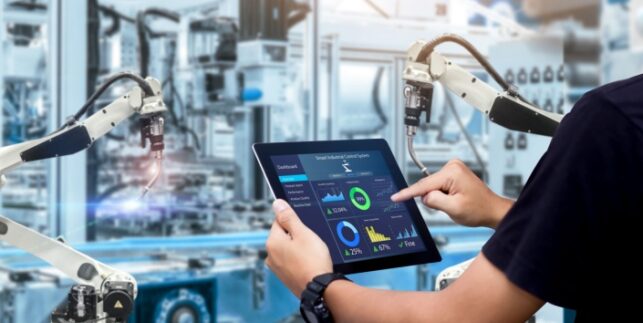Is Industry 5.0 Already on the Horizon for Manufacturers?

While many manufacturers are still grappling with the advancements of Industry 4.0, frontrunners across the industry are turning their sights toward the next step. Industry 5.0 encompasses emerging technologies and a new way of approaching manufacturing that is sure to bring massive benefits for early adopters.
What’s the Difference Between Industry 4.0 and Industry 5.0?
Depending on how far along your shop floor is on the digitalization journey, Industry 4.0 and Industry 5.0 may seem equally futuristic. However, Industry 4.0 is well-established today and now serves as the standard for a successful manufacturing operation.
Some Industry 4.0 technologies include the Internet of Things (IoT) to increase connectivity, the use of AI in various analytics, and the digitalization of the factory floor. These are now well-established technologies that your facility will be able to find numerous potential implementations for.
Industry 5.0, on the other hand, encompasses technologies that are just emerging today. They haven’t realized their full potential yet, and implantation is still being worked out by early adopters and risk-takers across the industry. It isn’t always clear how these technologies will fare in practical applications, but the rewards for the manufacturer that makes them work will be enormous.
Technologies and Trends Set to Define Industry 5.0
Industry 4.0 included many different technologies, and Industry 5.0 is set to do the same. These emerging technologies cover a wide range of areas, serving to deliver benefits on the shop floor and throughout organizations. There is also a shift in manufacturing philosophy that may see the landscape change dramatically in the coming years. These areas define the early days of Industry 5.0
Empowering Workers, Not Replacing Them
One of the most significant changes that Industry 5.0 is bringing with it is a more human-centric approach in an increasingly automated world. There’s no doubt that the automation provided by Industry 4.0 technologies has benefited manufacturers everywhere. However, its implantation left something to be desired – and Industry 5.0 is set to fix that.
Many types of automation, whether robotics on the shop floor or production data analytics, sought to replace the role of human employees. This certainly reduced costs and is favorable in many cases of menial and repetitive work, but manufacturers also lost something through this implantation. Instead of replacing employees, Industry 5.0 technologies hope to unlock their full potential.
The increased use of the IoT, AI, and other technologies can serve to help employees do their jobs better. They can create a more seamless interaction between humans and systems on the shop floor. Any given employee can have easier, faster, and more accurate access to data, analytics, and controls that they need to do their job.
These Industry 5.0 systems will get to know employees over time to work with them in the most effective and productive way. There’s no doubt that the ability to customize the metrics production teams see and how they can control production is an incredibly valuable tool. In the future, fine-tuning and customization will be handled by systems that can do it faster and more accurately.
Advanced AI Capabilities
AI has recently become one of the most discussed topics around the world as the release of large language models such as ChatGPT has shown staggering capabilities. However, AI has been in use in Industry 4.0 solutions for years now.
While solutions such as ChatGPT are incredible in their versatility and ease of use, powerful AI and machine learning already underlie many manufacturing solutions today. These purpose-built solutions analyze production data and provide insights and optimization. Chances are some form of AI is powering a solution your facility uses today, working in the background to deliver improved results.
With Industry 5.0, manufacturing will start to see the implantation of this new generation of AI. Solutions similar to ChatGPT could greatly improve the synergy between employees and manufacturing systems, allowing for plain-language queries. As these technologies are implemented into process control, quality, scheduling, and other systems, manufacturers will see even greater leaps in productivity.
AI is currently among the most anticipated aspects of Industry 5.0. A survey by Deloitte showed that 93% of manufacturers believe AI will be a pivotal technology in the immediate future. This new wave of AI is likely to have a major impact on manufacturing, both in ways that we can and cannot see.
Synergy Between Human Employees and Robots
Robots have been used in manufacturing environments for decades, carrying out a wide range of tasks. However, most implementations have kept robots and human employees separate, with parts or projects moving back and forth between automated and manual production lines.
Industry 5.0 is expected to see more direct cooperation between human employees and robots on the factory floor. Some are calling these machines cobots, a combination of collaborative and robot. They’ll work side-by-side with human employees in ways that weren’t possible before to do challenges in ensuring productivity and safety.
Robots are highly effective at carrying out the exact same motions time after time, but this doesn’t sync well with human employees. A human and robot working together will quickly go out of sync, as the robot can’t adjust speed or timing. Industry 5.0 cobots will solve this problem. They’ll be aware of the humans they work with and will be able to change their timing to match them.
The end result will be a factory floor where human employees benefit from the support of robots in a variety of tasks. They’ll work together just like any two human workers would, with the robot providing strength and precision and the human offering intuition and adaptability.
Intelligent Plant Process Management
Managing processes on the factory floor has always been a significant challenge. Industry 4.0 provided a variety of solutions, including increased connectivity and visibility. Various technologies enabled a real-time approach to production data, which opened the door to improved quality control, waste reduction, and more. Industry 5.0 builds on that foundation to make intelligent plant process management a reality.
Intelligent plant process management applies many of the same principles found throughout Industry 4.0 but uses them on a more holistic scale. The increased connectivity and control come together to allow all aspects of production to be coordinated together. Materials, equipment, and employees can all be put to the best possible use at any given moment.
Industry 5.0 will enable more complex tasks to be automated within a single system. This will allow for an optimized production schedule that takes both the current state of the factor floor and historical data into account. Predictive maintenance and other advanced features will be driven by AI and machine learning to reduce downtime and run operations more smoothly than ever before.
Mass Customization
Today, manufacturing operations fall into a few different categories depending on how often production parameters change. Some facilities create the same parts or goods for extended periods of time, requiring little variation in setup. Others work with custom orders, relying on significant preparation and often input from skilled workers to handle every work order.
Industry 5.0 will see the lines blur between these categories. A trend called mass customization is starting to see a high level of customization applied to mass production processes. A system that monitors all aspects of production and provides individual instructions for setup and processing enables customization on that scale.
This increases the versatility of manufacturers while still allowing them to operate at mass production scale. Work orders can feature extensive variation, but manufacturers won’t lose time in managing and preparing for changes on the shop floor. Instead, a single system will coordinate every detail to allow for the highest level of efficiency.
This is already something that we’re seeing in modern solutions. By aggregating and analyzing production data over the course of different work orders, the right solution can identify trends and allow for improved preparation and scheduling. Manufacturers can ensure that production teams are ready to handle setup quickly and accurately, even when work orders require rapid change on the factory floor.
Is Your Factory Floor Industry 5.0 Ready?
Does your factory floor have the foundation it needs to realize the benefits of Industry 5.0? New technologies are emerging quickly, and companies poised to take advantage of them today will be the winners 5, 10, and 20 years down the road. You can take action today to ensure that your operations are ready to seamlessly integrate new manufacturing techniques and technologies.
With Matics Real-time Operational Intelligence (RtOI), your operations have a solid foundation of real-time data aggregation and analysis that works with legacy systems, modern solutions, and the technology of tomorrow. You can achieve the visibility and control you need to implement the latest Industry 5.0 best practices and seamlessly integrate emerging technology.
At Matics, our team is always at work developing our solution to deliver the best that modern manufacturing has to offer. You can book a demo to see the difference that Matics RtOI can make on your factory floor today and in the future.





